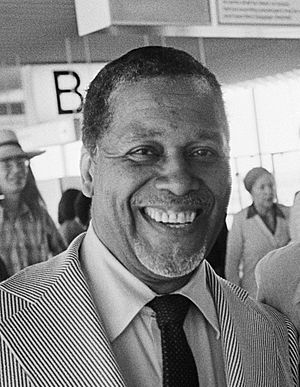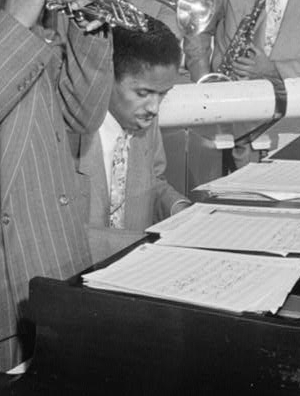John Lewis (pianist) facts for kids
Quick facts for kids
John Lewis
|
|
|---|---|

Lewis in 1977
|
|
| Background information | |
| Birth name | John Aaron Lewis |
| Born | May 3, 1920 La Grange, Illinois, U.S. |
| Died | March 29, 2001 (aged 80) New York, New York, U.S. |
| Genres | Jazz |
| Occupation(s) | Musician, composer, arranger |
| Instruments | Piano |
| Years active | 1940s–1990s |
| Associated acts | Modern Jazz Quartet |
John Aaron Lewis (born May 3, 1920 – died March 29, 2001) was an American jazz pianist. He was also a composer and arranger. He is best known for starting and leading the Modern Jazz Quartet.
Contents
Early Life and Music
John Lewis was born in La Grange, Illinois. When he was two months old, he moved to Albuquerque, New Mexico with his mother. She was a trained singer. John started learning classical music and piano at age seven. His family loved music and had their own family band. He also played in a Boy Scout music group.
Even though he learned classical piano, he heard a lot of jazz early on. His aunt loved to dance to jazz music. John went to the University of New Mexico. There, he led a small dance band. He studied Anthropology and Music. His piano teacher, Walter Keller, was very important to him. Lewis later honored him in a song.
In 1942, Lewis joined the Army. He played piano with Kenny Clarke. Clarke encouraged him to move to New York after the war. Lewis moved to New York in 1945. He studied music at the Manhattan School of Music. He earned a master's degree in music in 1953. In New York, he focused more on jazz. But he still played and listened to classical music often.
John Lewis's Jazz Career
When Lewis arrived in New York, Kenny Clarke introduced him to Dizzy Gillespie's big band. Lewis played a song he wrote and joined the band. This song, called "Two Bass Hit," became very popular. Lewis composed, arranged, and played piano for Gillespie's band from 1946 to 1948.
After touring Europe with Gillespie, Lewis left the band. He then worked with other famous jazz artists. He played with Charlie Parker on recordings like "Parker's Mood" (1948). He also worked with Lester Young, Ella Fitzgerald, and Illinois Jacquet.
Lewis also joined trumpeter Miles Davis for his "Birth of the Cool" recordings. Miles Davis asked Lewis to come back to the U.S. to work with him. Lewis arranged several songs for these important recordings.
Lewis, along with vibraphonist Milt Jackson, drummer Kenny Clarke, and bassist Ray Brown, played together in a small group. They often played short sets during Gillespie's concerts. This small group became very popular. In 1951, they formed their own band, first called the Milt Jackson Quartet. In 1952, they changed their name to the Modern Jazz Quartet.
The Modern Jazz Quartet
The Modern Jazz Quartet (MJQ) formed because the musicians wanted more freedom. They wanted to play more complex music than Gillespie's big band allowed. John Lewis wanted the MJQ to have more freedom to improvise. He also wanted to add classical music ideas to their songs.
Lewis noticed that bebop jazz focused only on the solo player. For the MJQ, he tried to balance the parts where they improvised with parts that were carefully arranged. Lewis became the musical director from the start. He helped the group's talent grow because of his own musical skills.
Lewis slowly changed the MJQ's style. He moved it away from the fast, wild bebop of the 1940s. Instead, he made it more refined and elegant. He created a "neoclassical style" of jazz. This style mixed bebop with the smooth sounds of jazz from the 1920s and 1930s.
Lewis also made sure the band always dressed perfectly. He believed they should look as polished as their music sounded. He once said that Duke Ellington's band was his model for elegance.
From 1952 to 1974, Lewis wrote and performed with the MJQ. His songs helped the MJQ become famous worldwide. They made jazz sound polite without losing its swing.
During this time, Lewis also had other important jobs. He led summer music sessions at the Lenox School of Jazz. He directed the annual Monterey Jazz Festival in California. He also started a big band called Orchestra U.S.A.. This band played "Third Stream" music. This style mixed classical music with jazz. Lewis helped create this new type of music. He also wrote music for films like Sait-On Jamais (1957) and Odds Against Tomorrow (1959).
The MJQ broke up in 1974. Milt Jackson felt they were not earning enough money. During this break, Lewis taught at the City College of New York and Harvard University. He also traveled to Japan and recorded his first solo piano album.
In 1981, the Modern Jazz Quartet got back together for tours. But they did not plan to play regularly. Since the MJQ was not his main job, Lewis formed a sextet called the John Lewis Group. In 1985, he helped start the American Jazz Orchestra. He also kept teaching jazz piano to students. He taught them to be good at blues, ballads, and fast-moving songs. He continued teaching for many years.
In 1989, Lewis received an honorary doctorate from Berklee College of Music. This award recognized his big impact on jazz.
In the 1990s, Lewis worked on many music projects. He played with Gerry Mulligan and Gunther Schuller. He recorded his last albums, Evolution and Evolution II, in 1999 and 2000. He also played with the MJQ until they finally stopped performing in 1997.
John Lewis played his last concert at Lincoln Center in New York. He played all kinds of music, from solo piano to big-band songs. He died in New York City on March 29, 2001, at age 80. He had been sick with prostate cancer. He was survived by his wife, Mirjana, his son, daughter, and three grandchildren.
John Lewis's Music Style
Style and Influences
Many jazz experts admired John Lewis's work. They said he knew exactly what he wanted from his musicians and his music. He achieved his goals with a quiet strength and modesty.
Lewis was greatly influenced by Count Basie's arranging style. Lewis played with a clear tone, making every note sound important. He was known for creating music that was spacious and powerful, yet refined. Because of his classical training and his experience with bebop, Lewis could mix these different styles. He made jazz sound more respectable, like classical concert music.
Lewis was also influenced by the improvisations of saxophonist Lester Young. He also learned from other great jazz pianists like Earl Hines. Lewis was very influenced by European classical music. Many of his songs for the MJQ used classical techniques like fugue (a type of musical chase) and counterpoint (two or more melodies played at the same time). He sometimes used string orchestras in his pieces.
In the early 1980s, Lewis enjoyed listening to pianists like Art Tatum, Hank Jones, and Oscar Peterson.
Piano Style
John Lewis played the piano with a straight posture and a serious look. He played without silly improvisations or mistakes. He could swing and play soulful blues. But his music sounded more like a concert hall than a smoky nightclub.
Even though he was a bebop pianist, Lewis was considered more traditional. He did not focus on fast, intense bebop. Instead, his piano style showed jazz as a "quiet conflict." His style mixed classical, bebop, and blues. This made people compare him to great pianists like Morton, Ellington, and Monk.
His improvisations were usually quiet, gentle, and understated. Lewis once told some saxophonists to "put yourself at the service of the melody." He meant that their solos should expand or shrink the main tune. He played his own solos this way too. He showed that a simple approach to a melody could create deep feelings.
His accompaniment for other musicians was also delicate. He often played simple counter-melodies (extra tunes) instead of just chords. These extra tunes blended with the solo and bass parts.
Compositions and Arrangements
Like his piano playing, Lewis's compositions were simple and minimalist. Many of his songs used short musical ideas and few chord changes.
His songs were influenced by 18th-century classical melodies. But they also showed a deep understanding of how to create musical tension and release. This was like the classic arrangements by Basie and Ellington. This mix of techniques made Lewis a leader in "Third Stream Jazz." This style combined classical European music with jazz's improvisation and big-band sounds.
Lewis experimented with writing fugues and using classical instruments in his songs. One newspaper wrote that his pieces mixed string orchestra and jazz quartet as equals. A music magazine said his works showed great control and a fresh way to combine improvisation with planned music.
Some of Lewis's best pieces for the MJQ include "Django" and the ballet suite The Comedy. Also, the four pieces "Versailles," "Three Windows," "Vendome," and "Concorde" are highly praised. These songs combine classical fugue ideas with jazz in a very effective way.
Discography
As leader/co-leader
| Year recorded | Title | Label |
|---|---|---|
| 1955 | The Modern Jazz Society Presents a Concert of Contemporary Music | Norgran |
| 1956 | Grand Encounter | Pacific Jazz |
| 1956 | Afternoon in Paris | Atlantic |
| 1957 | The John Lewis Piano | Atlantic |
| 1959 | Improvised Meditations and Excursions | Atlantic |
| 1960 | The Golden Striker | Atlantic |
| 1960 | The Wonderful World of Jazz | Atlantic |
| 1960 | Jazz Abstractions | Atlantic |
| 1962 | A Milanese Story | Atlantic |
| 1975 | P.O.V. | Columbia |
| 1976 | Statements and Sketches for Development | CBS |
| 1979 | An Evening with Two Grand Pianos | Little David |
| 1982 | Kansas City Breaks | Finesse |
| 1985 | J.S. Bach Preludes and Fugues from the Well-tempered Clavier Book 1 | Philips |
| 1999 | Evolution | Atlantic |
| 2000 | Evolution II | Atlantic |
With the Modern Jazz Quartet
- The Modern Jazz Quartet with Milt Jackson, Percy Heath, John Lewis, Kenny Clarke (1953, Prestige 160)
- Concorde (1955, Prestige 7005)
- Fontessa (1956, Atlantic 1231)
- Django (1956, Prestige 7057)
- The Modern Jazz Quartet Plays No Sun in Venice (Atlantic, 1958)
- Music from Odds Against Tomorrow (United Artists, 1959)
- Pyramid (Atlantic, 1960)
- The Comedy (1962, Atlantic 1390)
- Lonely Woman (Atlantic, 1962)
- The Legendary Profile (Atlantic, 1972)
- In Memoriam (Little David, 1973)
- Blues on Bach (Atlantic, 1973)
- The Last Concert (Atlantic, 1974)
- Reunion at Budokan 1981 (Pablo, 1981)
- Echoes (Pablo, 1984)
- Three Windows (Atlantic, 1987)
- For Ellington (East-West, 1988)
- MJQ & Friends: A 40th Anniversary Celebration (Atlantic, 1992–93)
As sideman
- With Miles Davis: The Complete Birth of the Cool (1948–50, Capitol Jazz)
- With Dizzy Gillespie: The Complete RCA Victor Recordings (Bluebird, 1937–1949, [1995])
- With Charlie Parker: The Genius of Charlie Parker (1945–8, Savoy MG 12009 [1956])
- With Sonny Rollins: Sonny Rollins at Music Inn (MetroJazz, 1958)
See also
 In Spanish: John Lewis (músico) para niños
In Spanish: John Lewis (músico) para niños


